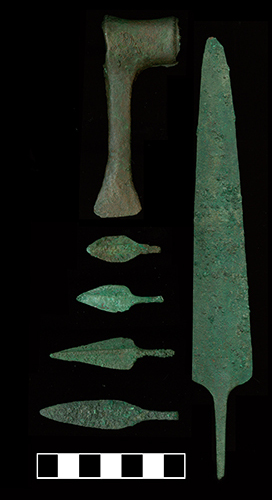Using AI to control energy for indoor agriculture
30 September 2024
Published online 16 May 2017
Ancient metal holds new clues to copper mining in ancient Arabia.

© Martina Renzi & J. Mark Kenoyer
To learn more, UCL Qatar’s Iron Age Metal Production in the Arabian Region and in the Levant project — funded by the Qatar Fund and led by Thilo Rehren and Martina Renzi – chemically analyzes metal from the early Iron Age (Iron I and II c. 1300 – 600 BCE) to understand ancient technologies, economies, and trade in this vast arid landscape1.
Little is known about the early Iron Age in the Arabian Peninsula, but Rehren and Renzi’s work is painting a picture.
Studying metals provides two different conduits for learning about the past, Rehren says. “There is an economic element to it, with metal you can store wealth and labour.”
“And if you look at the production waste and the workshops, you can understand what knowledge and practices crafts people had, and you can basically build lineages of learning and traditions.”
Rehren adds, metals “provide an insight into everyday people, in addition to those of the elite who are storing the final product.”
For Arabia, the term Iron Age is seemingly misleading as iron artifacts were not very common. Renzi says this is probably because copper is naturally abundant in the Arabian Peninsula, particularly in Oman. Iron smelting demands very high heat, says the researcher, requiring lots of fuel resources, which would have been a challenge. Archaeologists, however, use the term Iron Age to point to a specific time-period.
Rehren and Renzi’s project, with the cooperation of many archaeologists in the region, has examined metal from numerous settlements in Oman, the Emirates, and in Saudi Arabia.
In the Late Bronze Age (c. 1500 – 1300 BCE), long-distance trade had boomed, with Omani copper flowing into Syria and Mesopotamia, explains Rehren. Archaeologists are trying to piece together this politically and economically fragmented region after this trade network collapsed in the Iron Age.
Renzi explains that connecting metal objects with chemical signatures from ore allows them to identify a metal’s provenance. These chemical signatures have changed the picture of Iron Age Arabia, with the team discovering a new source of copper that sheds light on local metal production and trade in the region.
"The Arabian Peninsula needs to be studied not assumed."
Tin-bronze, roughly 8-10% tin, was the most common copper-alloy in the early Iron Age in the Near East, replacing the earlier arsenical copper alloy, according to Rehren. In the Iron Age Arabian Peninsula, however, “you often find copper with a little bit of tin and a little bit of arsenic.”
Rehren says general consensus was that Arabs were recycling scrap metal and mixing everything together. Yet, the team’s analytical work shows that they were smelting an alloy in Arabia, resulting in a small amount of tin and arsenic occurring naturally.
This has far reaching implications, Rehren points out, “I think it shows they were doing their own thing here, independent of the outside world.”
This copper alloy, from a specific source, was found all over the region, which is surprising because it shows “long distance trade in areas that were previously not supposed to be connected,” Renzi reports.
For example, Rehren explains, archaeologists previously thought copper items excavated from settlements in Saudi Arabia came from the closest and commonly exploited copper source in Timna, located in the Arabah Valley, south of the Dead Sea basin. But Rehren and Renzi’s work found that some of the copper objects had chemical signatures from Oman as well as Timna, demonstrating that copper traveled a great distance through the Arabian Peninsula. This indicates a wide reaching copper trade network.
Renzi sees the Arabian copper trade as a “continuous flow” where people “traded all sorts of things, including raw materials, ores, metal, finished objects … even scrap was recycled.”
The chemical analysis of Arabian metal indicates region metal production was not a “heavily organized state monopolized economy, but a much more independent small scale active economic situation,” says Rehren.
Through identifying local exploitation of metal resources and a thriving inter-regional flow of goods, the research team has demonstrated that the Arabian Peninsula “needs to be studied in its own right and it can not be assumed, based on studies elsewhere in the Levant and in Africa, that things would be the same here.”
doi:10.1038/nmiddleeast.2017.86
Stay connected: